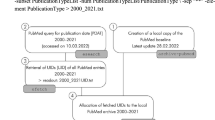Abstract
In the last few decades, multi-authored articles have increased in different disciplines with increasing instances of authorship abuse although multi-authorship is not always due to undeserving authorship (McDonald et al. in Mayo Clin Proc 85(10):920–927, 2010). It may be necessitated by interdisciplinary research, the evolution of a discipline, or the intention of quality improvement. This article studies the relationship between the authorship and the quality of articles (publications in better impact factor journals or core journals) in the field of Oceanography. The result shows ~75 % increase in the number of authors per article from 1990 to 2009 in the discipline. The increase in authorship correlates not only with the percentage of articles in core journals but also with the mean impact factor (IF) of journals (where the articles were published). The ANOVA study shows that though multi-authorship has no influence on the preference to publish in core journals during the 1990s or 2000s, it does have a significant influence on the preference to publish in high IF journals in both the decades. So these findings establish that in the field of Oceanography, the increase in collaboration would have resulted in more publications in core journals (without any influence of authorship increase) and in better impact factor journals (due to the influence of authorship increase).




Similar content being viewed by others
References
Baethge, C. (2008). Publish together or perish. Deutsches Ärzteblatt International, 105(20), 380–383.
Baum, J. A. C. (2011). Free-riding on power laws: Questioning the validity of the impact factor as a measure of research quality in organization studies. Organization, 18, 449–466.
Birnholtz, J. P. (2006). What does it mean to be an author? The intersection of credit, contribution, and collaboration in science. Journal of the American Society for Information Science and Technology, 57(13), 1758–1770.
Birnholtz, J. (2008). When authorship isn’t enough: Lessons from CERN on the implications of formal and informal credit attribution mechanisms in collaborative research. Journal of Electronic Publishing, 11(1). doi:10.3998/3336451.0011.105.
Bradford, S. C. (1985). Sources of information on specific subjects. Journal of Information Science, 10(4), 173–180.
Calcagno, V., Demoinet, E., Gollner, K., Guidi, L., Ruths, D., & de Mazancourt, C. (2012). Flows of research manuscripts among scientific journals reveal hidden submission patterns. Science, 338(6110), 1065–1069.
Campbell, P. (1999). Policy on papers’ contributors. Nature, 399(6735), 393.
Figg, W. D., Dunn, L., Liewehr, D. J., Steinberg, S. M., Thurman, P. W., Barrett, J. C., et al. (2006). Scientific collaboration results in higher citation rates of published articles. Pharmacotherapy, 26(6), 759–767.
Greenland, P., & Fontanarosa, P. B. (2012). Ending honorary authorship. Science, 337(6098), 1019.
Kressel, H. Y., & Dixon, A. K. (2011). Where is the honor in honorary authorship? Radiology, 259(2), 324–327.
Kumar, V., Upadhyay, S., & Medhi, B. (2009). Impact of the impact factor in biomedical research: Its use and misuse. Singapore Medical Journal, 50(8), 752–755.
McDonald, R. J., Neff, K. L., Rethlefsen, M. L., & Kallmes, D. F. (2010). Effects of author contribution disclosures and numeric limitations on authorship trends. Mayo Clinic Proceedings, 85(10), 920–927.
Papatheodorou, S. I., Trikalinos, T. A., & Ioannidis, J. P. A. (2008). Inflated numbers of authors over time have not been just due to increasing research complexity. Journal of Clinical Epidemiology, 61(6), 546–551.
Reynolds, T. M., & Wierzbicki, A. S. (2004). Does activity in research correlate with visibility? Journal of Clinical Pathology, 57(4), 426–427.
Rieder, S., Bruse, C. S., Michalski, C. W., Kleeff, J., & Friess, H. (2010). The impact factor ranking—a challenge for scientists and publishers. Langenbeck’s Archives of Surgery, 395, S69–S73.
Sacco, W. P., & Milana, S. (1984). Increase in number of authors per article in ten APA journals: 1960–1980. Cognitive Therapy and Research, 8(1), 77–84.
Saha, S., Saint, S., & Christakis, D. A. (2003). Impact factor: A valid measure of journal quality? Journal of the Medical Library Association, 91(1), 42–46.
Sahu, S. R., & Panda, K. C. (2012). A deductive approach to select or rank journals in multifaceted subject, Oceanography. Scientometrics, 92, 609–619.
Shaban, S., & Aw, T.-C. (2009). Trend towards multiple authorship in occupational medicine journals. Journal of Occupational Medicine and Toxicology, 4(3), doi:10.1186/1745-6673-4-3.
Strange, K. (2008). Authorship, why not just toss a coin? American Journal of Physiology—Cell Physiology, 295(3), C567–C575.
Teixeira da Silva, J. A. (2011). The ethics of collaborative authorship. EMBO Reports, 12(9), 889–893.
Ware, M. (2008). Peer review: Benefits, perceptions and alternatives. Publishing Research Consortium, London. Retrieved April 13, 2013, from http://www.publishingresearch.net.
Yank, V., & Rennie, D. (1999). Disclosure of researcher contributions: A study of original research articles in the Lancet. Annals of Internal Medicine, 130(8), 661–670.
Acknowledgments
We express gratitude to the Director, National Institute of Oceanography (CSIR) and Dr. M. P. Tapaswi for the support and facilities provided in this academic and research endeavour. Thanks to Dr. Rajeev Saraswat for stimulating discussions and comments. First author is also very thankful to the research supervisor Dr. K. C. Panda, Ex-Professor, Sambalpur University for his continuous encouragement. This is NIO contribution number 5446.
Author information
Authors and Affiliations
Corresponding author
Rights and permissions
About this article
Cite this article
Sahu, S.R., Panda, K.C. Does the multi-authorship trend influence the quality of an article?. Scientometrics 98, 2161–2168 (2014). https://doi.org/10.1007/s11192-013-1127-0
Received:
Published:
Issue Date:
DOI: https://doi.org/10.1007/s11192-013-1127-0




